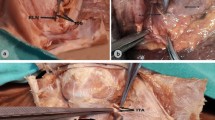Abstract
The neck–tongue syndrome (NTS) is a disorder, due to the compression of the second cervical root nerve. The compression occurs either at the atlanto-axial space or at the exit of the hypoglossal nerve. Many factors can be held responsible for the development of the lesion, including atlanto-axial dislocation, rheumatoid arthritis and irritation from the nearby tectorial membrane and/or capsule of the atlanto-axial joint. A cadaveric specimen study was undertaken in order to identify the ligament of Arnold, one of the predisposing factors involved in the development of this syndrome. Eight cadaveric specimens were dissected and the ligament of Arnold (accessory atlantoaxial ligament) was identified. A full investigation was performed. In half of the cases, the ligament was extending upwards to the occipitum We observed that Arnold’s ligament was found to be contracted during rotational movements of the head, while in flexion-extension, it was rather relaxed. During the rotation of the head it could, under certain circumstances, irritate the second cervical nerve root as well as the hypoglossal nerve at its exit from the foramina magna.
Résumé
Le syndrome Cervico-hypoglosse (NTS pour Neck-Tongue Syndrome) est dû à une compression de la deuxième racine nerveuse cervicale. La compression se produit soit dans l’espace atlas-axis, soit à l’émergence du nerf hypoglosse. Beaucoup de facteurs peuvent être avancés pour expliquer cette lésion, incluant la luxation atlas-axis, arthrose rhumatoïde, l’irritation du nerf par la membrane tectoriale et/ou la capsule de l’articulation axo-atloïdienne. Une étude cadavérique a été entreprise pour identifier le ligament d’Arnold, l’un des facteurs prédisposants dans l’installation de ce syndrome. Huit cadavres ont été disséqués et le ligament d’Arnold (ligament atlanto-axial accessoire) a été mis en évidence. Une investigation complète a ensuite été réalisée. Dans la moitié des cas, le ligament se poursuivait vers le haut, vers l’occiput. Nous constatâmes que le ligament se tendait lors des mouvements de rotation et était plutôt relâché en flexion-extension. Lors de la rotation dela tête, il peut dans certaines circonstances, irriter le deuxième nerf cervical ainsi que le nerf hypoglosse dans son émergence du foramen magnum.




Similar content being viewed by others
References
Aidi S, El Alaoui Faris M, Mkinssi N, Bourezza M, Jidanne M, Chkili T (1997) Neck-tongue syndrome: a case caused by atlanto-axial osteoarthritis of tuberculous origin.Article (in French). Rev Neurol (Paris) 153(11):694–696
Bassett S. George (1991):Neck disorders in little people; LPA today/September–November. http://www.lpo.on.ca./NECK DISORDERS.HTM
Bodguk N (1981) An anatomical basis for the neck-tongue syndrome. J Neurol Neurosurgery Psychiatry 44(3):202–208
Borody C (2004) Neck–tongue syndrome. J Manipulative Physiol Ther. 27(5)
Caillet H, Delvalle A, Doyon D, Sigal R, Francke JP, Halimi P, Bely N. (1990) Visibility of cranial nerves at MRI. J Neuroradiol 17(4):289–302
Caillet H, Delvalle A, Doyon D, Sigal R, Francke JP, Halimi P, Bely N (1991) The normal cranial nerves in MRI.Description and visualization frequency. J Radiol 72(2):69–78
Castro S, Verstraete K, Mielants H, Vanderstraeten G, de Reuck J, Veys EM. (1994) Cervical spine involvement in rheumatoid arthritis: a clinical, neurological and radiological evaluation. Clin Exp Rheumatol 12(4):369–374
Elisevich K, Stratford J, Bray G, Finlayson M. (1984) Neck–tongue syndrome: operative management. J Neurol Neurosurg Psychiatry 47(4):407–409
Gray H (1918). Articulation of the Atlas with the Epistropheus or Axis (Articulatio Atlantoepistrophica) 5b, In: Anatomy of the human body. Lea & Febiger, Philadelphia, p.295. Bartleby.com, 2000. http://www.bartleby.com/107/
Hsu HP, Chen ST, Chen CJ, Ro LS (2004) A case of Collet-Sicard syndrome associated with traumatic atlas fractures and congenital basilar invagination. J Neurol Neurosurg Psychiatry 75(5):782–784
Korres SD (1999) Αnatomic elements. In: Korres SD (ed) The cervical spine traumatology–pathology. Medical Publications Litsas, Athens, Chap. 2, pp.25–38
Lance JW, Anthony M (1980) Neck–tongue syndrome on sudden turning of the head. J Neurol Neurosurgery Psychiatry 43(2):97–101
Lewis DW, Frank LM, Toor S (2003) Familial neck-tongue syndrome. Headache 43(2):132–134
O’Meara M , Wise G (1995) Painful torticollis with tongue atrophy—a different neck–tongue syndrome. Neuropediatrics 26(5):276–280
Orrell RW, Marsden CD (1994) The neck-tongue syndrome. J Neurol Neurosurg Psychiatry 57(3):348–352
Paturet G (1951): Articulations de la tete avec le rachis cervical. Ιn Ostéologie, Arthrologie, Myologie,Tome 1, Masson e Cie, France, pp 540–554
Rabadan AT, Sevlever G (2000) Hypertrophic atlantoaxial ligaments: an unusual cause of compression of the upper spinal cord. J Neurol Neurosurg Psychiatry 68:116–117
Roy-Camille et al (1986): Rachis cervical supérieur. In: Roy-Camille et al. Anatomie fonctionnelle de la charnière rachidienne. Roy-Camille, Masson et Cie, Paris, pp 10–15
Sweikh AM, al Atrakshi S (1998) A rare case of hypoglossal nerve palsy complicating a head injury. J Accid Emerg Med 15(6):427–429
Tubbs RS, Salter EG, Oakes WJ (2004) The accessory atlantoaxial ligament. Neurosurgery 55(2):400–402
Watanabe A, Ishii R, Okamura H, Shirabe T (1998) Magnetic resonance imaging of non-specific inflammatory granulation involving the skull base-two case reports. Neurol Med Chir (Tokyo) 38(2):104–106
Webb J, March L, Tyndall A (1984) The neck-tongue syndrome: occurrence with cervical arthritis as well as normals. J Rheumatol 11(4):530–533
Author information
Authors and Affiliations
Corresponding author
Rights and permissions
About this article
Cite this article
Tsakotos, G.A., Anagnostopoulou, S.I., Evangelopoulos, D.S. et al. Arnold’s ligament and its contribution to the neck–tongue syndrome (NTS). Eur J Orthop Surg Traumatol 17, 527–531 (2007). https://doi.org/10.1007/s00590-007-0245-x
Received:
Accepted:
Published:
Issue Date:
DOI: https://doi.org/10.1007/s00590-007-0245-x




